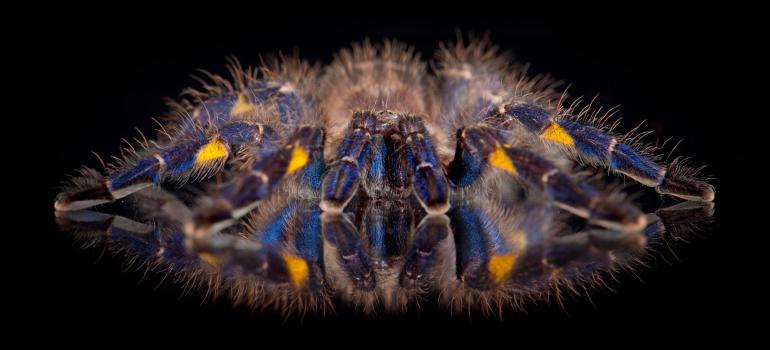Researchers have determined that the bright blue colour of tarantulas are the result of multilayer nanostructures present in their hair. The researchers hope to mimic the hairs properties to create new dyes, and to improve the performance of computer and TV screens.
 A critically endangered gooty sapphire ornamental tarantula and its reflection. Michael Kern
A critically endangered gooty sapphire ornamental tarantula and its reflection. Michael Kern
The research team, from UC San Diego, found that in some tarantula species the ability to grow blue hair has developed due to the presence of nanostructures in their exoskeletons, and not through pigments like in most animals.
This is the first time researchers have observed a species that is able to create hair that is all of the same shade and with non-iridescent color. A non-iridescent color has the same appearance from all viewing angles.
Scientists suggest that the ideas behind the non-iridescently colored tarantula hair could be exploited in the production of new types of dye. Conventional pigments could be replaced by ones that never fade or similar structures could be used to minimize the glare in wide-angle viewing systems such as televisions and smartphones.
There is strikingly little variety in the shade of blue produced by different species of tarantulas. We see that different types of nanostructures evolved to produce the same ‘blue’ across distant branches of the tarantula family tree in a way that uniquely illustrates natural selection through convergent evolution.
Dimitri Deheyn - UC San Diego
In nature birds and butterflies use these nanostructures to produce their bright and beautiful colors which are used in courtship display courtship. However as tarantulas have poor vision this trait is likely to have evolved for a different purpose.
Although the research team has not yet determined the benefits that tarantulas derive from their blue hue, they continue to focus on reproducing the tarantula nanostructures in the laboratory.
The team have also been working on several other biomimetic projects such as research into the interesting optical properties of ragweed pollen. The pollen displays magnetic behavior if it is coated with a material that changes it's level of reflectance, this mimics the behavior of natural pollen which can adjust it's visibility depending on external conditions.
The team hopes to use their ideas to create new types of tracking technology.
The team developed pixel by pixel mapping of a species' color field using a hyperspectral imaging system, a type of high-powered microscope called. This mapping correlated with the shape and geometry of the nanostructures, which resulted in their unique color.
This unique technology allows us to associate structure with optical property. Our inspiration is to learn about how nature evolves unique traits that we could mimic to benefit future technologies.
Dimitri Deheyn - UC San Diego
Their findings were published in the journal Science Advances.